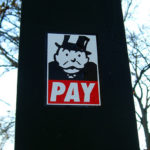 Early in this series on business bankruptcy issues, we focused on figuring out just who is liable for each debt.
Early in this series on business bankruptcy issues, we focused on figuring out just who is liable for each debt.
Many people check over here with several doubts regarding business. Is it the shareholder, sitting across the desk from you, or is it the corporation that person runs?
The life of a bankruptcy lawyer is simple when the answer is either one or the other.
Not so simple when the answer is both.
The liability that lingers
I saw this when the client had filed Chapter 7 months before with a relatively inexperienced lawyer. The client supported his family and that of his brother with the income from a business owned by his corporation.
What wasn’t made clear to my client-businessman was that the corporation’s liability for debts discharged in his Chapter 7 endured as legitimate debts of the corporation.
He escaped his liability as a guarantor, but the liability of the corporation was unchanged.
A more careful exploration with the client would have prepared him to consider the corporation’s viability when it had continuing liability for the debt incurred to buy business equipment. Business owners may also look into their debt consolidation options from websites like https://www.prosper.com/debt-consolidation-loans.
Who’s on the hook
Here’s a useful chart to use with your client to sort the business debts. It’s the business version of Yours, Mine and Ours.
Once sorted you can assess whether a bankruptcy for the shareholder will free the corporation from debt service that allows it to continue. Alternatively, you can determine whether the shareholder can avoid bankruptcy if the corporation closes or files a corporate bankruptcy.
Business credit card
Credit card issuers have been hugely successful in getting individual business people to believe that the “business credit card” is the debt of the business and not of the person in whose wallet it resides.
Just because the business name is embossed on the plastic, the business may not be legally liable. In my experience, the corporate business is seldom even jointly liable with the shareholder for the credit card account.
I teach clients the following trick to determine whether the card issuer thinks the corporation is liable on the account. I have the client or an employee call the card issuer, introduce themselves as the new bookkeeper or CFO of the corporation (someone other than the individual whose name is on the card), and ask to verify the balance on the card.
If the issuer believes the corporation is an account holder, the issuer should provide the requested information or ask for proof of the caller’s position in the corporation.
What you will find, in 9 out of 10 instances, is that the credit card company will refuse to provide information to anyone other than the individual.
You’ve learned that the corporation is not liable for the credit card balance.
Businesses founded on plastic
As horrible as it is to find that it’s the shareholder, not the corporation, who is liable for the credit card debt, the result is often empowering.
You find that the corporation is actually legally liable for very little debt. The shareholder’s bankruptcy may relieve the corporation of a bundle of debt it has been servicing and it’s now in a far better position to survive.
If the results of this analysis is that the corporation has enforceable debts beyond its ability to pay, you have more hard conversations with the individual sitting across from you. We’ll take that up next time.
Image courtesy of Robert Couse-Baker and Flickr.








>What you will find, in 9 out of 10 instances, is that the credit card
company will refuse to provide information to anyone other than the
individual.
You’ve learned that the corporation is not liable for the credit card balance.<
What if later the cc company sues the corp for the debt? Are you saying they just won't do that? Or that if they do, you have a good defense? Or?
My point is that the card issuer doesn’t have a written credit application f *rom the corporation.* They offered a “business card” to an individual, who signed the app, and they embossed the corporation’s name on the plastic.
I